You may never have given much thought to St. Erasmus, but if you wander past any vegetable vendor in any season here — especially in the spring — you will see him referred to constantly. Not because he was so holy, though undoubtedly he was; the reference is very specifically to the nearby island which is named for him: Sant’ Erasmo.
What’s on Sant’ Erasmo are fields and fields of market gardens. On a summer evening, strolling along the verdant lanes that glimmer with fireflies, flailing at billows of insatiable mosquitoes, it’s like having been transported back to somewhere in the heart of darkest Indiana.
In Venice, any mention of the largest island in the lagoon, particularly if it’s scribbled on a sign in the market, is synonymous with the best local produce. Peas, asparagus, artichokes; by June, they have all come and are mostly gone, though the last flourishes are on sale at the annual Venetian rowing race marking the good saint’s feast day (June 2, as all the world knows).
Sant’ Erasmo is known, not only by its celestial verdure, but its few hardy and well-entrenched families. If I were to tell you that there are only a few last names here, which have been continually reshuffled as the generations have gone on, I will have told you just about everything you need to know about the place. I’m not implying children with six fingers, just that it’s a little planet orbiting Venice, near but extremely far, if you follow me. Anybody with the surname Vignotto, Zanella, Smerghetto, or Bubacco can only be from here, and you would pick them out immediately even if you were to meet them racing yachts at Cowes, on their way to pick up their Nobel Prize.
A few Sunday mornings ago, our usual group gathered at the boat club, ready to head out somewhere in the gondolone, the big gondola. We’d heard there was going to be some local farmers’ fiesta on the island, the “Festa of the Violet Artichoke of Sant’ Erasmo,” so we rowed over there. We needed a new destination for our Sunday excursion, and it took less than an hour. We drew the boat up on the sandy beach (look at the map for the little stretch of shore along the southwestern edge) and wandered ashore to see what the islanders had organized.
Naturally we were there too early. We should have known. 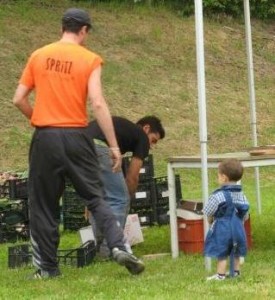
The Violet Artichoke growers’ lobby has recently succeeded in having their product officially designated as a protected brand, akin to a denomination controlee’. This little thistle deserves all the fanfare it can get: Stripped down to its tender inner leaves and slowly sauted over a low flame in olive oil and garlic, it has a very particular bitterness which is transmuted in your mouth into a flavor tending mysteriously towards sweetness. I think they must contain some narcotic substance; once you start, you must have more.
Everyone maintains that part (or all) of the secret of these little morsels is the saline environment. 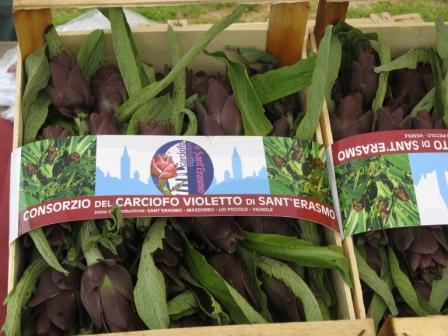
So: Did we buy any, or not? Yes, we did. But not from the festa. The canny farmers with their snazzy labels and tents were charging one euro ($1.38) apiece. I wish I could say I’d made that up.
Therefore we walked across the road to the large shady fig tree, under which a lone farmer was selling the artichokes he had just cut from their 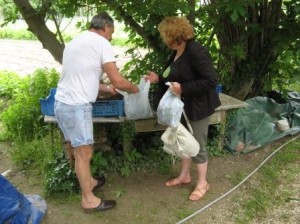
He could undoubtedly have asked a higher price if he’d been selling them as “castraure” (kas-tra-OO-reh). This is one of those legendary food items that is much rarer than you’d think, considering how many vegetable vendors claim to be selling them. The castraure are the first, topmost little artichoke on each plant; they are cut off (yes, the plant is castrated…) in order to encourage the rest of the plant to flourish. This flourishing is in the form of the little artichokes we bought, which are called “botoli.”
It makes me happy to remember all this, because they’re gone from my life for another year. I probably won’t make it back to Sant’ Erasmo before the race in June, and by the time I get there all the good stuff will have been sold. Of course, I could eat artichokes virtually all year from hothouses all over Italy, but now that I’ve tasted these I think I’ll just wait.


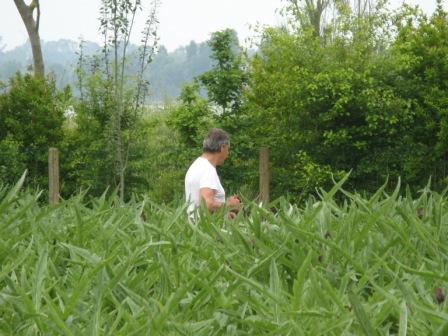
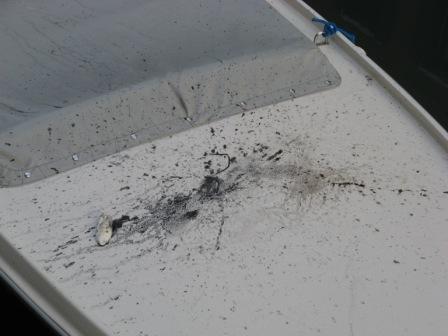 and a battle ensued, which the seppia lost. You can tell by the splashings of desperate black ink. Another clue is the cuttlebone, which if I had a parakeet or Andean condor I would immediately have taken.
and a battle ensued, which the seppia lost. You can tell by the splashings of desperate black ink. Another clue is the cuttlebone, which if I had a parakeet or Andean condor I would immediately have taken. 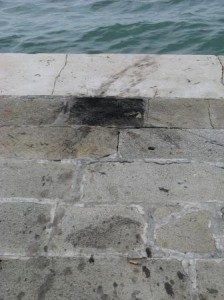 Many of them indicate epic battles, all futile.
Many of them indicate epic battles, all futile.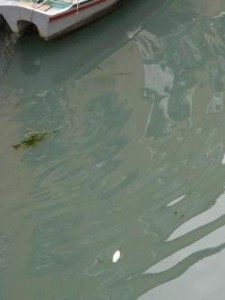
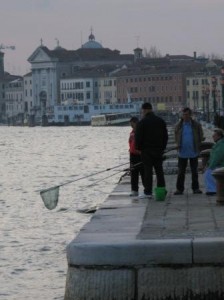 They often go out at night, too, depending on the tides, rigging up a strong light to attract the animals. Or they use a fish-like lure. Lino once slew a vast number of them by hooking a medium-length remnant of a white plastic bag to his line and pulling it slowly through the water; despite the fact that seppie have some of the most developed eyes in the animal kingdom, it somehow looked irresistibly like another seppia. They don’t eat only crabs, shrimp, worms, or whatever — they snack on each other, as well. Too much information?
They often go out at night, too, depending on the tides, rigging up a strong light to attract the animals. Or they use a fish-like lure. Lino once slew a vast number of them by hooking a medium-length remnant of a white plastic bag to his line and pulling it slowly through the water; despite the fact that seppie have some of the most developed eyes in the animal kingdom, it somehow looked irresistibly like another seppia. They don’t eat only crabs, shrimp, worms, or whatever — they snack on each other, as well. Too much information?  One more thing: It may not be very likely that you’ll be buying seppie in the fishmarket, but if you are looking at them for whatever reason, you should know that the whiter they are (it’s more like a ghastly gray mortuary pallor), and the more smeared with sticky black ink, the older they are. Lots of ink is a Bad Sign.
One more thing: It may not be very likely that you’ll be buying seppie in the fishmarket, but if you are looking at them for whatever reason, you should know that the whiter they are (it’s more like a ghastly gray mortuary pallor), and the more smeared with sticky black ink, the older they are. Lots of ink is a Bad Sign.